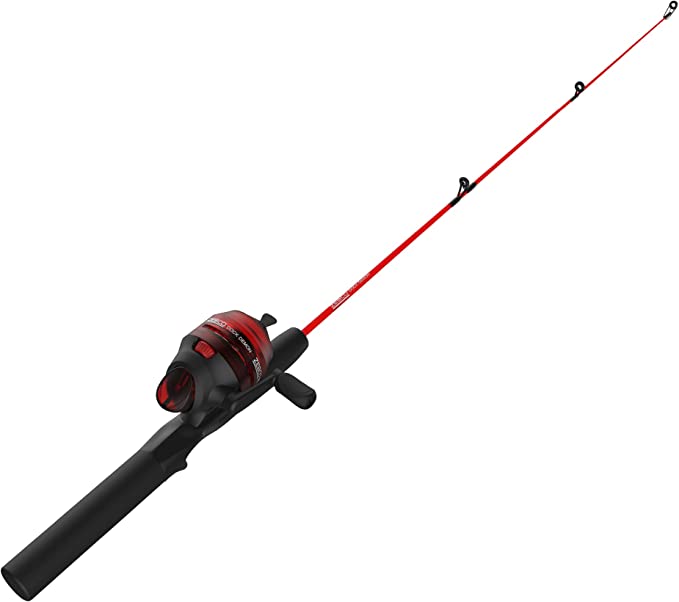The Physics of the Unbreakable: Engineering the Ultimate Dock Rod
Update on Nov. 18, 2025, 7:09 p.m.
In the lexicon of angling, “performance” is almost exclusively synonymous with “sensitivity.” We are sold on high-modulus graphite, aerospace-grade resins, and blanks so light they feel like extensions of our nervous systems. But there is another metric of performance, often overlooked until the moment of catastrophic failure: toughness.
While graphite is akin to a Formula 1 car—fast, precise, but fragile—there exists a class of tools designed like tanks. The Zebco Dock Demon represents this alternative engineering philosophy. Often dismissed as a mere novelty or a child’s toy due to its 30-inch stature, it is, in reality, a masterclass in the application of solid fiberglass mechanics and mechanical leverage. To understand why this micro-rod has cultivated a cult following among serious anglers, kayak fishermen, and urban structure hunters, we must look past its price tag and into its physics.
Material Science: The “Solid” Advantage
The primary failure mode of modern fishing rods is “hoop stress” collapse. Tubular (hollow) graphite rods achieve their lightness by creating a thin-walled cylinder. When bent excessively, the cross-section ovalizes, and the wall buckles—snap.
The Dock Demon circumvents this entirely by utilizing a solid fiberglass blank. * Strain Energy Density: Fiberglass (specifically E-Glass) has a lower modulus of elasticity than graphite. This means it stretches significantly more before failure. By making the blank solid, the rod can absorb an immense amount of strain energy. It creates a structure that doesn’t buckle; it simply bends until the load is relieved. * Impact Resistance: Graphite micro-fractures when struck against a dock piling or dropped on a rock. Solid fiberglass is functionally amorphous and resilient. It can withstand the blunt force trauma of the “dock life”—being stepped on, jammed in rod holders, or slammed in car doors—without compromising its structural integrity.

The Physics of the Lever: Why Shorter is Stronger
When you fight a fish with a 7-foot rod, physics is actually working against you. The rod acts as a third-class lever. The fulcrum is your hand, the effort is applied by your wrist, and the load (the fish) is at the tip. A longer lever arm means the fish has the mechanical advantage. You have to exert significantly more force to lift a 5-pound bass with a 7-foot rod than you do with a 30-inch rod.
The 30-inch length of the Dock Demon drastically alters this equation.
1. Reduced Moment Arm: The distance between the fulcrum (your hand) and the load is minimized. This shifts the mechanical advantage back to the angler.
2. Vertical Lifting Power: In dock fishing or ice fishing scenarios, you are often lifting dead weight vertically. The short, stiff spine of the micro-rod acts less like a whip and more like a crane boom. This allows for “boat flipping” or “dock lifting” fish that would shatter a longer, high-modulus rod.
Torque vs. Speed: The Reel’s Gear Geometry
The accompanying reel is often criticized for being “slow,” but this is a feature, not a bug, of its intended use case. With a gear ratio of 4.3:1, the reel acts as a winch.
High-speed reels (6.2:1 or 7.1:1) sacrifice torque for line retrieval speed. However, when you are trying to pull a fish out from under a pylon or through heavy weeds with a short rod, you need torque. The lower gear ratio provides the mechanical gearing necessary to turn the handle under heavy load without binding. It is the difference between trying to pedal a bicycle uphill in high gear versus low gear. The Dock Demon is permanently in “low gear,” optimized for the grunt work of close-quarters extraction.
The “Urban Angling” Application
Understanding these mechanics unlocks new tactical possibilities. The Dock Demon is not just for bluegill; it is a precision instrument for Structure Fishing. * Shooting Docks: The short length allows for “bow-and-arrow” casts into tight skips under walkways where long rods simply cannot maneuver. * Kayak Cockpits: In the confined space of a kayak, a long rod can be cumbersome to land fish with. The micro-rod allows you to bring the fish right to the gunwale without high-sticking (a common cause of rod breakage).
Conclusion: Engineering for the Extreme
The Zebco Dock Demon challenges the notion that “better” always means “more expensive.” It proves that “better” means “better suited for the task.” By prioritizing solid-state material density over modulus, and mechanical leverage over reach, it occupies a unique niche in the angler’s arsenal. It is a tool engineered not for the finesse of the open water, but for the brutal, close-range combat of the dock, the pier, and the shoreline structure.



















